Jungle Tour on Christmas Island

Take Off
Jörgen Wennberg
Fri 22 Sep 2017 14:24
Some more history….At Australia's request, the UK transferred sovereignty to Australia, with a M$20 million payment from the Australian government to Singapore as compensation for the loss of earnings from the phosphate revenue. The UK’s Christmas Island Act was given royal assent on 14 May 1958, enabling Britain to transfer authority over Christmas Island from Singapore to Australia by an order-in-council. Australia's Christmas Island Act was passed in September 1958 and the island was officially placed under the authority of the Commonwealth of Australia on 1 October 1958.In a media statement on 5 August 1960, the minister for territories, Paul Hasluck, said, among other things, that, "His extensive knowledge of the Malay language and the customs of the Asian people... has proved invaluable in the inauguration of Australian administration... During his two years on the island he had faced unavoidable difficulties... and constantly sought to advance the island's interests." The settlement of Silver City was built in the 1970s, with aluminium-clad houses that were supposed to be cyclone-proof. The 2004 Indian Ocean earthquake and tsunami centred off the western shore of Sumatra in Indonesia, resulted in no reported casualties, but some swimmers were swept some 150 metres (490 ft) out to sea for a time before being swept back in. The second day we joined a Jungle Tour with Indian Ocean Experiences on Christmas Island taking us all around the “dog” island (on the map Christmas Island looks like a dog). We drove up the hill to have a good look at the Flying Fish Cove where we were all anchored. 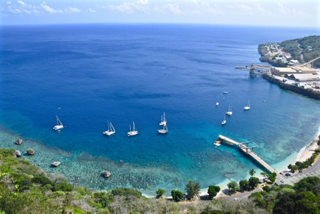  Take Off being the smallest boat in the fleet is anchored by the fleet’s biggest boat, Solo.   This is a beautiful bird typical for the Indian Ocean. 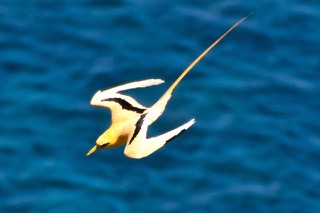 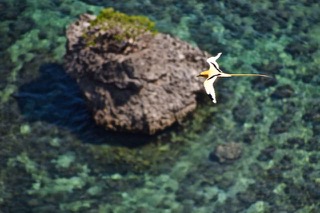  We passed this arch being installed by the locals especially for the crabs during their mating season when they migrate from the woods down to the sea. In order to protect them from the traffic the arch is made for the crabs to “cross” the road more safely. The red crabs' annual migration from the island's forested interior to its rugged coastline in order to spawn has been described by Sir David Attenborough as one of the planet's greatest wildlife spectacles. 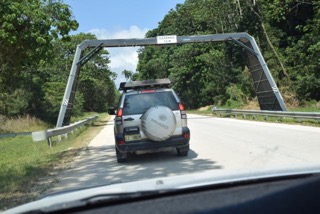  The Refugee and Immigration detention From the late 1980s and early 1990s, boats carrying asylum seekers, mainly departing from Indonesia, began landing on the island. In 2001, Christmas Island was the site of the Tampa controversy, in which the Australian government stopped a Norwegian ship, MV Tampa, from disembarking 438 rescued asylum-seekers. The ensuing standoff and the associated political reactions in Australia were a major issue in the 2001 Australian federal election. The Howard government operated the "Pacific Solution" from 2001 to 2007, excising Christmas Island from Australia's migration zone so that asylum seekers on the island could not apply for refugee status. Asylum seekers were relocated from Christmas Island to Manus Island and Nauru. In 2006, an immigration detention centre, containing approximately 800 beds, was constructed on the island for the Department of Immigration and Multicultural Affairs. Originally estimated to cost A$276 million, the final cost was over $400 million. In 2007, the Rudd government decommissioned Manus Regional Processing Centre and Nauru detention centre; processing would then occur on Christmas Island itself. In December 2010, 48 asylum-seekers died just off the coast of the island in what became known as the Christmas Island boat disaster when the boat they were on, hit rocks off Flying Fish Cove, and then smashed against nearby cliffs. As of 20 June 2013, after the interception of four boats in six days, carrying 350 people, the Immigration Department stated that there were 2,960 "irregular maritime arrivals" being held in the island's five detention facilities, which exceeded not only the "regular operating capacity" of 1,094 people, but also the "contingency capacity" of 2,724. I remember reading the news a few years ago concerning Christmas Island being on the worldwide news as they had more than 3 times as many refugees in their detention centre than the 800 people they could take. Nowadays the detention centre serves as a transit for the refugees being expelled from Australia due to committed crime before they are sent back home to their original country. The centre is also used as a “hotel” when the flights are delayed for the next destination.   Our next stop is Hugh’s Dale Waterfall. These woods are home for many different types of crabs. This one below is called the Robber Crab as it robs anything that crosses its way. The Robber Crab can live up to 70 years.   These tiny small ants caused the death of many crabs in 2002. The inhabitants of Christmas Island discovered a carpet of dead crabs covering the forests wondering what disease had hit them. After some research they discovered that the "Crazy Ants" kill the crabs by spraying them with formic acid. It makes the crabs blind, they start frothing at the mouth, and they die in as little as two hours."The ants then eat their insides out. The ants were accidentally introduced to Christmas Island in the 1930s, possibly in shipments of timber. But it was only in the 1990s that they became a serious problem, after the evolution of multi-queened super colonies. They found that the 12,000 hectare island was infested with almost 80 super colonies, in which the ants are found at densities of 1,000 per square metre. In order to control this vast death of the red crabs, a tiny wasp was introduced to the island killing them and controlling the number of “Crazy Ants” and the eco-system came back to normal. 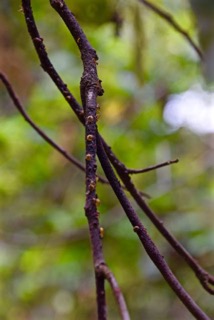  Another different crab as well as a huuuuge grasshopper.  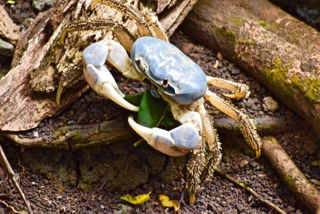  A very inquisitive Alex taking possession of the guide.  Tahitian chestnut trees: these buttress-rooted trees thrive on the permanent water surface here.   More crabs!  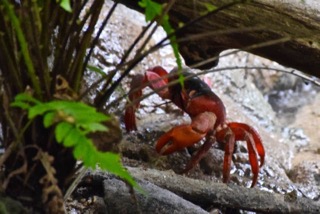   Visiting the Hugh’s Dale Waterfall    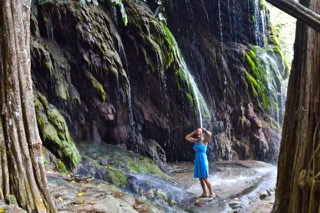    We continued further to the Blowholes: these limestone pinnacles have been sculpted by the harsh eroding effects of salt spray, wind, rain and sun. Cracks, fissures and holes have formed in the rock. Waves have also shaped the coastline by wearing away and undercutting the sea cliff. The surge of swells against the sea cliff forces the sea water up through the cracks and fissures with such force that it is thrown high into the air. 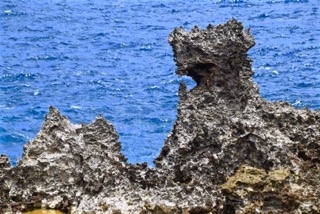    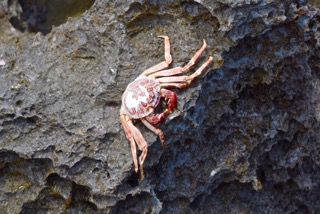  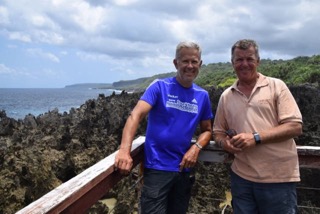    And off on the road again….  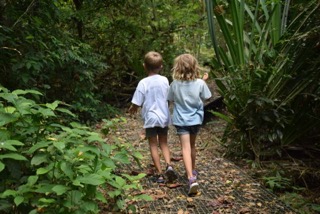 … now stopping at Margaret Knoll to experience the lovely view as well seeing a red footed boobies nest. 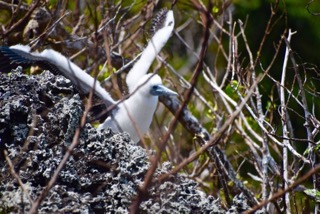  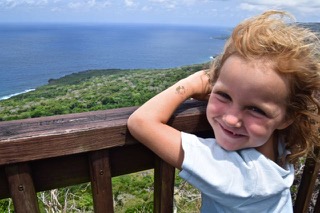 … and fruit bats!   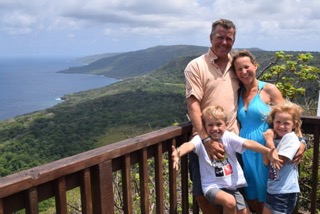 |